
Lilium lancifolium is an Asian species of lily, native to China, Japan, Korea, and the Russian Far East. It is widely planted as an ornamental because of its showy orange-and-black flowers, and sporadically occurs as a garden escapee in North America, particularly the eastern United States including New England, and has made incursions into some southern states such as Georgia.

Lilium is a genus of herbaceous flowering plants growing from bulbs, all with large prominent flowers. They are the true lilies. Lilies are a group of flowering plants which are important in culture and literature in much of the world. Most species are native to the northern hemisphere and their range is temperate climates and extends into the subtropics. Many other plants have "lily" in their common names, but do not belong to the same genus and are therefore not true lilies.
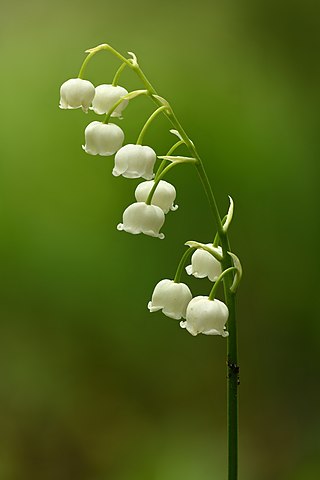
Lily of the valley, sometimes written lily-of-the-valley, is a woodland flowering plant with sweetly scented, pendent, bell-shaped white flowers borne in sprays in spring. It is native throughout the cool temperate Northern Hemisphere in Asia and Europe. Convallaria majalis var. montana, also known as the American lily of the valley, is native to North America.

A daylily or day lily is a flowering plant in the genus Hemerocallis, a member of the family Asphodelaceae, subfamily Hemerocallidoideae. Despite the common name, it is not in fact a lily. Gardening enthusiasts and horticulturists have long bred daylily species for their attractive flowers. Thousands of cultivars have been registered by local and international Hemerocallis societies. Daylilies are perennial plants, whose name alludes to its flowers, which typically last about a day.

Lilium bulbiferum, common names orange lily, fire lily,Jimmy's Bane,tiger lily and St. John's Lily, is a herbaceous European lily with underground bulbs, belonging to the Liliaceae.

Lilium candidum, the Madonna lily or white lily, is a plant in the true lily family. It is native to the Balkans and Middle East, and naturalized in other parts of Europe, including France, Italy, and Ukraine, and in North Africa, the Canary Islands, Mexico, and other regions. It has been cultivated since antiquity, for at least 3,000 years, and has great symbolic value since then for many cultures. It is susceptible to several virus diseases common to lilies, and especially to Botrytis fungus. One technique to avoid problems with viruses is to grow plants from seed instead of bulblets.

Lilium philadelphicum, also known as the wood lily, Philadelphia lily, prairie lily, or western red lily, is a perennial species of lily native to North America.
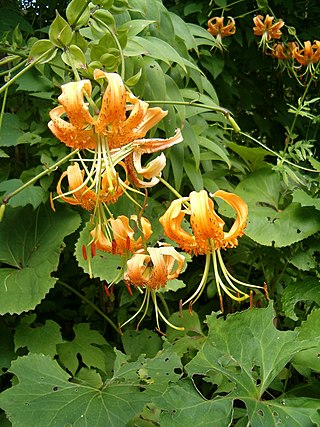
Lilium henryi, sometimes called tiger lily or Henry's lily, is a native lily of the mountains of central China. The flowers are orange, spotted black, and unscented. The petals are recurving, and eventually resemble those of the more widespread Turk's-cap lily.

Lilium speciosum is an East Asian species of plants in the lily family. It is native to southern Japan and southern China, where it can be found at elevations of 600–900 metres (2,000–3,000 ft). It is sometimes called the Japanese lily though there are other species with this common name.

Lilium pardalinum, also known as the leopard lily or panther lily, is a flowering bulbous perennial plant in the lily family, native to Oregon, California, and Baja California. It usually grows in damp areas. Its range includes California chaparral and woodlands habitats and the Sierra Nevada.
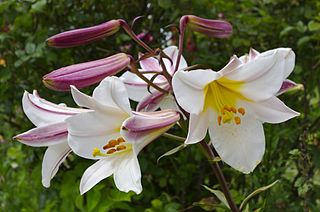
Lilium regale, called the regal lily, royal lily, king's lily, or, in New Zealand, the Christmas lily, is a species of flowering plant in the lily family Liliaceae, with trumpet-shaped flowers. It is native to the western part of Sichuan Province in southwestern China, and cultivated elsewhere as an ornamental. It was introduced to England in 1903 by Ernest Henry Wilson.

Hemerocallis fulva, the orange day-lily, tawny daylily, corn lily, tiger daylily, fulvous daylily, ditch lily or Fourth of July lily, is a species of daylily native to Asia. It is very widely grown as an ornamental plant in temperate climates for its showy flowers and ease of cultivation. It is not a true lily in the genus Lilium, but gets its name from the superficial similarity of its flowers to Lilium and from the fact that each flower lasts only one day.
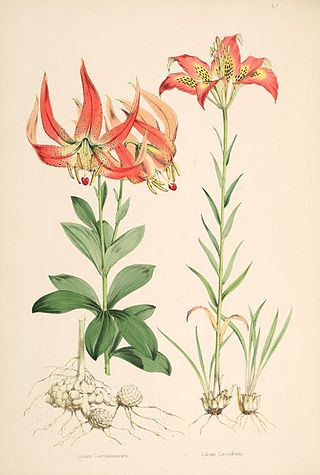
Lilium michauxii, commonly known as the Carolina lily, can be found in the southeastern United States from southern Virginia in the north to the Florida Panhandle in the south to eastern Texas in the west. It is most common in July and August but can be found blooming as late as October. It was named for the French botanist André Michaux, who traveled and did extensive research throughout the Southeast.

Lilium superbum is a species of true lily native to the eastern and central regions of North America. Common names include Turk's cap lily, turban lily, swamp lily, lily royal, or American tiger lily. The native range of the species extends from southern New Hampshire, Massachusetts, and New York, west to Illinois, Missouri, and Arkansas, and south to Georgia, Alabama, Mississippi, and Florida.

Lilium pyrenaicum is native to montane regions, mainly the Pyrenees, from Spain and eastwards, with the range extending into the Caucasus. It grows up to 1.3 m high. It bears up to 12 Turks-cap shaped flowers. These are yellow, orange or red, and has an unusual musky scent, which some people find unpleasant.

Yucca gloriosa is a species of flowering plant in the family Asparagaceae, native to the southeastern United States. Growing to 2.5 m (8 ft), it is an evergreen shrub. It is widely cultivated as an ornamental for its architectural qualities, and has reportedly become established in warmer climates in the wild in various parts of the world.

Lilium pumilum is an Asian species of bulbous plants native to Mongolia, Siberia, the Russian Far East, Korea and northern China.
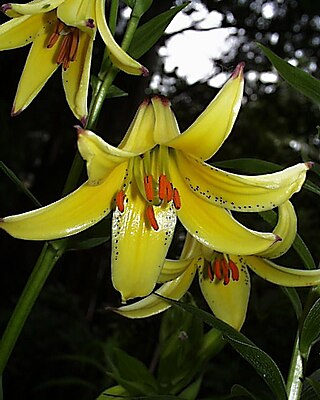
Lilium monadelphum is a bulbous plant native to Crimea and to North and South Caucasus.

Lilium medeoloides is an East Asian herb in the lily family. It is native to southeast China, Jeju-do in Korea, Japan and eastern Russia, where it grows in forests and on grassy and rocky subalpine areas.

Lilium hansonii, known as Hanson's lily and Japanese turk's-cap lily, is an East Asian species of plants in the lily family. It is native to Korea, Japan, and to Jilin Province in northeastern China, as well as being widely cultivated as an ornamental.





















